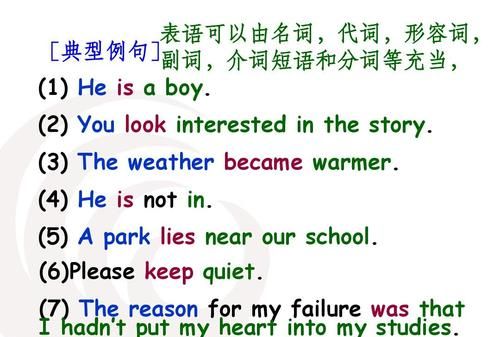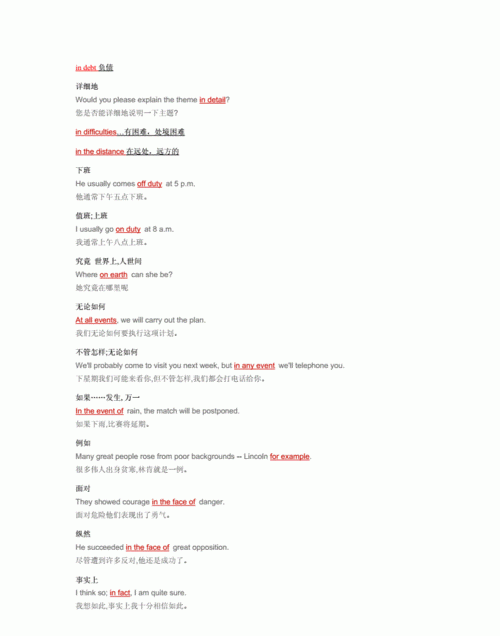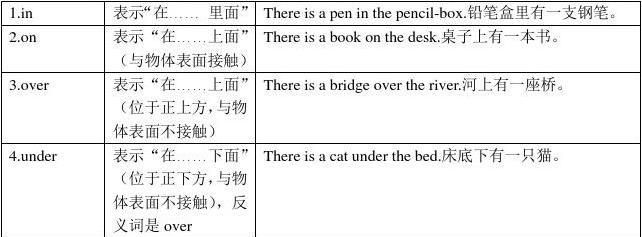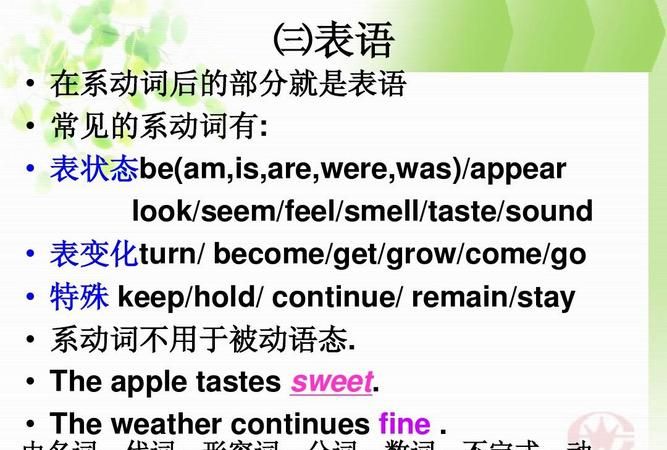本文目录
形容词、数词、名词、介词短语、动词不定式做定语时的例句包括翻译
形容词:This is a 【beautiful】 garden.这是个美丽的花园.
数词:I have【 six 】classes a day.我每天上六节课.
名词:My father works in a 【shoe】 factory.我父亲在鞋厂工作.
介词短语:The boy 【under the tree】is Jim.树下的那个男孩是Jim.
动词不定式:Would you like something 【to drink】?你想要点喝的东西吗?

there be+名词+介词短语造句
没听过这个结构,
有there be 结构的 。是写错了吧
There is a bird in the tree.
There is a book on the desk.
There are many fruits on the table .

介宾短语介词+名词
这是语文题吧

初中动词加介词的短语
1.in+语言/颜色/衣帽等,表示使用某种语言或穿着……。
2.in + Row/ Team/ Class/ Grade等,表示“在……排/队/班级/年级”等。
3.in the morning/ afternoon/ evening/ 表示“在上午/下午/傍晚”等一段时间。
4.in the desk/ pencil-box/bedroom 等表示“在书桌/铅笔盒/卧室里”。
5.in the tree表示“在树上 (非树本身所有)”;on the tree表示“在树上(为树本身所有)”。
6.in the wall表示“在墙上(凹陷进去)”;on the wall表示“在墙上(指墙的表面)”。
7.at work(在工作)/at school(上学)/at home(在家)应注意此类短语中无the。
8.at + 时刻表示钟点。
9.like this/that表示方式,意为“像……这/那样”。
10.of短语表示所属关系。
11.behind/ beside/ near/ under+ 名词等,表示方位、处所。
12.from与to多表示方向,前者意为“从……”,后者意为“到……”。
另外,以下这些短语也必须掌握。如:on duty, after breakfast, at night, at the door, in the middle, in the sky, on one’s bike等。
初中英语知识总结--短语、词组和重点句型归纳短语、词组归纳 由动词开头构成的短语、词组很多。复习时应分类处理: 一、动词+介词 1.look at…看…,look like … 看上去像……, look after …照料… 2.listen to…听…… 3.welcome to…欢迎到…… 4.say hello to …向……问好 5.speak to…对……说话 此类短语相当于及物动词,其后必须带宾语,但宾语无论是名词还是代词,都要放在介词之后。如: This is my new bike. Please look it after.(×) This is my new bike. Please look after it.(√) 二、动词+副词 “动词+副词”所构成的短语义分为两类: A.动词(vt.)+副词 1.put on 穿上 2.take off脱下 3.write down记下 此类短语可以带宾语,宾语若是名词,放在副词前后皆可;宾语若是人称代词,只能放在副词的前面。试比较: First listen to the tape, then write down the answer/write the answer down. (√) First listen to the answer, then write down it.(×) First listen to the answer, then write it down.(√) B.动词(vi)+副词。 1.come on赶快 2.get up起床 3.go home回家 4.come in进来 5.sit down坐下 6.stand up起立 此类短语属于不及物动词,不可以带宾语。 三、其它类动词词组 1.close the door 2.1ook the same 3.go to work/class 4.be ill 5.have a look/seat 6.have supper 7.1ook young 8.go shopping 9.watch TV/games 10. play games. 介词短语聚焦 “介词+名词/代词”所构成的短语称为介词短语。现将Unitsl-16常用的介词短语按用法进行归类。 1.in+语言/颜色/衣帽等,表示使用某种语言或穿着……。如:in English,in the hat 2.in + Row/ Team/ Class/ Grade等,表示“在……排/队/班级/年级”等。 3.in the morning/ afternoon/ evening/ 表示“在上午/下午/傍晚”等一段时间。 4.in the desk/ pencil-box/bedroom 等表示“在书桌/铅笔盒/卧室里”。 5.in the tree表示“在树上 (非树本身所有)”;on the tree表示“在树上(为树本身所有)”。如:There are some in the tree. There are many apples on the trees. 6.in the wall表示“在墙上(凹陷进去)”;on the wall表示“在墙上(指墙的表面)”。如:There’re four windows in the wall, and there is a map on the back wall. 7.at work(在工作)/at school(上学)/at home(在家)应注意此类短语中无the。 8.at + 时刻表示钟点。如:at six, at half , past ten. 9.like this/that表示方式,意为“像……这/那样”。 10.of短语表示所属关系。如:a picture of a classroom, a map of China. 11.behind/ beside/ near/ under+ 名词等,表示方位、处所。如:beside/ near the door, under/ behind the tree. 12.from与to多表示方向,前者意为“从……”,后者意为“到……”。如:from one to ten, (go) to school/ bed/ work. 另外,以下这些短语也必须掌握。如:on duty, after breakfast, at night, at the door, in the middle, in the sky, on one’s bike等。 重点句型大回放 1.I think…意为“我认为……”,是对某人或某事的看法或态度的一种句型。其否定式常用I don’t think…,如:I think he’s Mr Zhinag. (L17)I don’t think you are right. 2.give sth. to sb./ give sb. sth. 意为“把……给……”,动词give之后可接双宾语,可用这两种句型;若指物的宾语是人称代词时,则只能用give it/ them to sb. 如: His parents give him a nice purse./His parents give a nice purse to him. Give it to Mr Hu.(L57) 3.take sb./ sth. to…意为“把……(送)带到……”,后常接地点,也可接人。如: Please take the new books to the classroom. 4.One…, the other…/One is…and one is…意为“一个是……;另一个是……”,必须是两者中。如:One is red and one is grey.(L50)或 One is red,, the other is grey. 5.Let sb. do sth. 意为“让某人做某事”,人后应用不带to的动词不定式,其否定式为Don’t let sb,do sth.,或Let sb. not do sth. 另外,Let’s 与Let us的含义不完全相同,前者包括听者在内,后者不包括听者在内,如:Let’s go for a walk./Let us try once more, please. 6.help sb. (to) do sth./help sb. with sth.意为“帮助某人做某事”,前者用不定式作宾补,后者用介词短语作宾补,二者可以互换。如:Let me help you find it.(L42)/Let me help you with it. 7.What about…?/How about…?意为“……怎么样?”是用来询问或征求对方的观点、意见、看法等。about为介词,其后须接名词、代词或V-ing等形式。如:What/How playing chess? 8.It’s time to do…/ It’s time for sth. 意为“该做……的时间了”,其中to后须接原形动词,for后可接名词或V-ing形式。如:It’s time to have supper. =It’s time for supper. 9.like to do sth./like doing sth.意为“喜欢做某事”,如:Li Lei and his friends like to play in the tree house. (L 43)前一种句型侧重具体的一次性的动作;后一种句型侧重习惯性的动作,试比较: Tom likes swimming, but doesn’t like to swim this afternoon. 10.ask sb.(not) to do sth. 意为“让某人(不要)做某事”,其中ask sb.后应接动词不定式,如: Ask your friends to guess what is in it. (L44) 11.show sb. sth. / show sth. to do. 意为“把某物给某人看”,该句型的用法同前面第2点。如: Show your friend your family photo.(L36)/Show your family photo to your friend. 12.introduce sb. to sb. 意为“把某人介绍给另一人”;introduce to sb.则是“向某人作介绍”。如:Introduce your family to her.
1.初中英语教材中共出现近500个词组,其中有一部分为常用词组,要求能熟练运用.
2.在学习中,要注意词组的积累,特别要注意介词词组和短语动词的积累.
3.对固定词组的意义,切不可望文生义.例如,动词look愿意为“看”,但look after意为“照料”,look up (a word in a dictionary)意为“(在词典中)查找(单词)”.
4.要十分注意固定词组中冠词的使用.有时冠词可引起词义的变化,例如,go the school意为“上学”,而go to the school意为“到学校里去”;take place意为“发生”,而take the place意为“取代”.有些词组中须用冠词,而另一些则不用.例如,in the evening, at night.
一、动词词组(包括短语动词)、介词词组和其他词组
(一)由be构成的词组
***/question/afe0a977df40457add5aa4ef7345c899.html

以上就是关于名词加介词短语例句 ,英语有些名词前面加上一个介词是什么语法呢的全部内容,以及名词加介词短语例句 的相关内容,希望能够帮到您。

